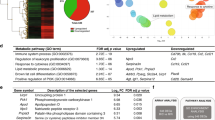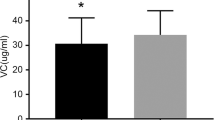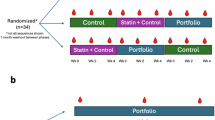Abstract
Objective:
Protamine has been shown to have an inhibitory effect on protein lipase in vitro; the objective of this study was to evaluate the antiobesity activity effect of protamine in obese induced rats, and to evaluate the effect of protamine on postprandial hypertriacylglyceridemia in rats by intragastric administration of a lipid emulsion containing corn oil.
Design:
Two experiments were carried out: (1) In a parallel study in rats, we administered a lipid emulsion containing corn oil plus 0, 200 or 500 mg kg–1 of protamine intragastrically. (2) In a randomized parallel prospective rats experiment, rats were fed with a high-fat diet and 0, 200 or 500 mg of protamine per kg of animal weight during 5 weeks.
Subjects:
Male Sprague–Dawley rats.
Measurements:
In experiment 1, plasma triacylglycerol levels after oral administration of lipid emulsion were determined. In experiment 2, weight gain, concentrations of plasma triacylglycerol, plasma total cholesterol and albumin were determined, and the subcutaneous and visceral adipose tissues were weighed.
Results:
Plasma triacylglycerol concentration in rats administered with 200 or 500 mg kg–1 of protamine was significantly lower than that in rats in the control group (200 mg kg–1 of protamine, P<0.05 at 1, 2, 3 and 4 h; 500 mg kg–1 of protamine P<0.05 at 2, 3 and 4 h). In rats fed with a high-fat diet, and 200 and 500 mg kg–1 of protamine, there was a decreased body weight gain by 52 and 66 g, respectively, reduced visceral fat by 5 and 8 g, respectively and subcutaneous tissue weights by 12 and 15 g, respectively. Plasma triacylglycerol was 17 and 45 mg per 100 ml lower in rats fed with high-fat diet plus 200 and 500 mg kg–1 of protamine, respectively. And cholesterol concentrations were 18 and 22 mg per 100 ml lower in both protamine groups, respectively.
Conclusion:
Our study demonstrates that protamine reduce weight gain and body fat accumulation through the inhibition of dietary fat absorption.
This is a preview of subscription content, access via your institution
Access options
Subscribe to this journal
Receive 12 print issues and online access
$259.00 per year
only $21.58 per issue
Buy this article
- Purchase on SpringerLink
- Instant access to full article PDF
Prices may be subject to local taxes which are calculated during checkout


Similar content being viewed by others
References
WHO Expert Consultation. Appropriate body-mass index for Asian populations and its implications for policy and intervention strategies. Lancet 2004; 363: 157–163.
Kopelman PG . Obesity as a medical problem. Nature 2000; 404: 635–643.
Salvador J, Silva C, Santos E . Pharmacological treatment of obesity. An Sist Sanit Navar 2002; 25: 143–161.
Weigle D . Pharmacological therapy of obesity: past, present and future. J Clinl Endocrinol Metab 2003; 88: 2462–2469.
Luque CA, Rey JA . The discovery and status of sibutramine as an anti-obesity drug. Eur J Pharmacol 2002; 440: 119–128.
Hill JO, Hauptman J, Anderson JW, Fujioka K, O'Neil PM, Smith DK et al. Orlistat, a lipase inhibitor, for weight maintenance after conventional dieting: a 1-y study. Am J Clin Nutr 1999; 69: 1108–1116.
Drew BS, Dixon AF, Dixon JB . Obesity management: update on orlistat. Vasc Health Risk Manag 2007; 3: 817–821.
Han LK, Xu BJ, Kimura Y, Zheng Y, Okuda H . Platycodi radix affects lipid metabolism in mice with high fat diet-induced obesity. J Nutr 2000; 130: 2760–2764.
Yoshikawa M, Ninomiya K, Shimoda H, Nishida N, Matsuda H . Hepatoprotective and antioxidative properties of Salacia reticulata: preventive effects of phenolic constituents on CCl4-induced liver injury in mice. Biol Pharm Bull 2002; 25: 72–76.
Satouchi K, Kodama Y, Murakami K, Tanaka T, Iwamoto H, Ishimoto M . A lipase-inhibiting protein from lipoxygenase-deficient soybean seeds. Biosci Biotechnol Biochem 2002; 66: 2154–2160.
Tani H, Ohishi H, Watanabe K . Purification and characterization of proteinous inhibitor of lipase from wheat flour. J Agric Food Chem 1994; 42: 2382–2385.
Tsujita T, Matsuura Y, Okuda H . Studies on the inhibition of pancreatic and carboxylester lipases by protamine. J Lipid Res 1996; 37: 1481–1487.
Ando T, Yamasaki M, Suzuki K . Protamines: isolation, characterization, structure and function. Mol Biol Biochem Biophys 1973; 12: 1–114.
Birari RB, Bhutani KK . Pancreatic lipase inhibitors from natural sources: unexplored potential. Drug Discov Today 2007; 12: 879–889.
Rosado JL, García-Padilla S, Duarte-Vázquez MA . Composition for the treatment of obesity and hiperlipidemia. PCT/MX2005/000058, 2004.
Koopman R, Schaart G, Hesselink MKC . Optimisation of oil red O staining permits combination with immunofluorescence and automated quantification of lipids. Histochem Cell Biol 2001; 116: 63–68.
Tani H, Ohishi H, Watanabe K . When flour lipase inhibitor decreases serum lipid levels in male rats. J Nutr Sci Vitaminol (Tokyo) 1995; 41: 699–706.
Kido Y, Hiramoto S, Murao M, Horio Y, Miyazaki T, Kodama T et al. Epsilon-polylysine inhibits pancreatic lipase activity and suppresses postprandial hypertriacylglyceridemia in rats. J Nutr 2003; 133: 1887–1891.
Carey MC, Small DM, Bliss CM . Lipid digestion and absorption. Annu Rev Physiol 1983; 45: 651–677.
Bergstrom RW, Newell-Morris LL, Leonetti DL, Shuman WP, Wahl PW, Fujimoto WY . Association of elevated fasting C-peptide level and increased intra-abdominal fat distribution with development of NIDDM in Japanese-American men. Diabetes 1990; 39: 104–111.
Hoeg JM, Maher MB, Bailey KR, Brewer Jr HB . The effects of mevinolin and neomycin alone and in combination on plasma lipid and lipoprotein concentrations in type II hyperlipoproteinemia. Atherosclerosis 1986; 60: 209–214.
Farnsworth WH, Hoeg JM, Maher M, Brittain EH, Sherins RJ, Brewer Jr HB . Testicular function in type II hyperlipoproteinemic patients treated with lovastatin (mevinolin) or neomycin. J Clin Endocrinol Metab 1987; 65: 546–550.
Acknowledgements
The study was partially supported by CONACYT-Secretaria de Economía, México, Grant NO. ECO-2003-16076. Thanks are given to the Human Nutrition Group of the Universidad Autónoma de Querétaro for allowing us the utilization of their facilities.
Author information
Authors and Affiliations
Corresponding author
Rights and permissions
About this article
Cite this article
Duarte-Vázquez, M., García-Padilla, S., Olvera-Ochoa, L. et al. Effect of protamine in obesity induced by high-fat diets in rats. Int J Obes 33, 687–692 (2009). https://doi.org/10.1038/ijo.2009.78
Received:
Revised:
Accepted:
Published:
Issue date:
DOI: https://doi.org/10.1038/ijo.2009.78
Keywords
This article is cited by
-
Effects of protamine hydrochloride from chum salmon milt on lipid metabolism in rats
Fisheries Science (2011)



